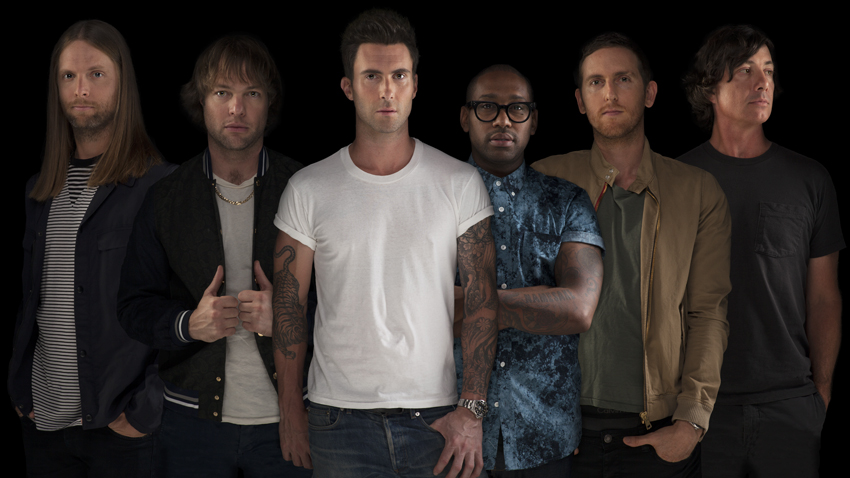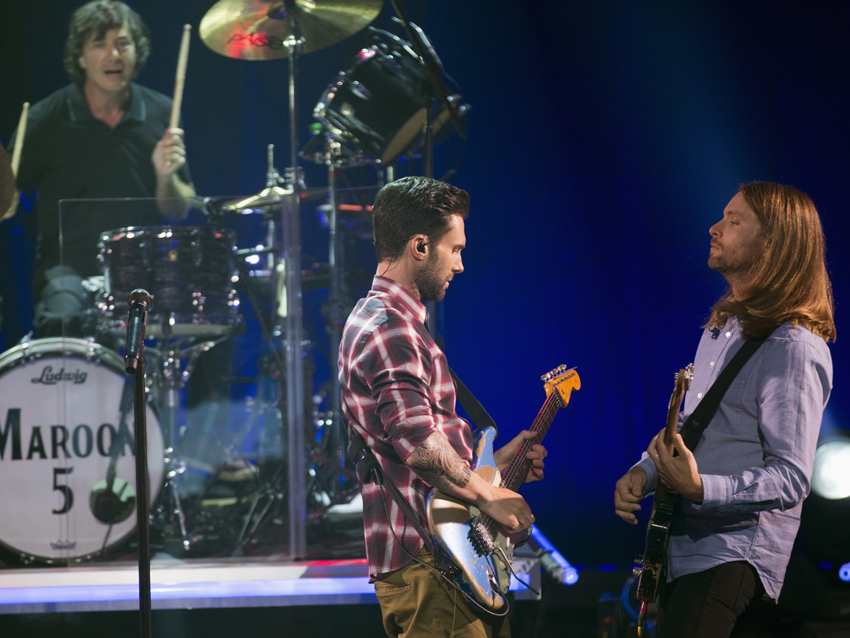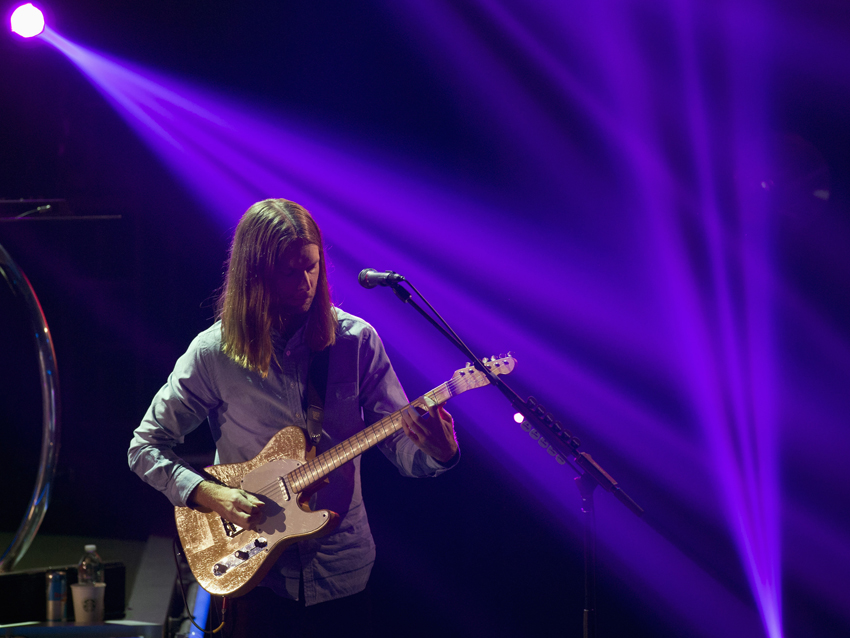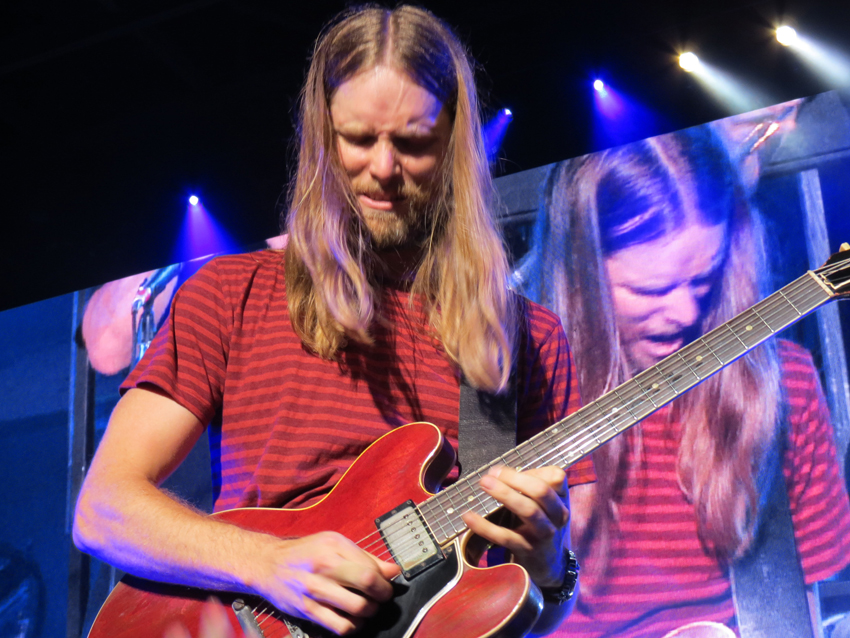
James Valentine talks guitars, influences and Maroon 5's new album, V
Guitarist James Valentine is riding in a car to LAX, preparing to catch a flight to London, where his band, Maroon 5, will headline the 11th night of the month-long iTunes Festival. On this very day, it will be announced that the group's new album (appropriately titled V, as it's their fifth long-player) will debut next week in the number one spot on Billboard's Top 200. Reflecting on Maroon 5's remarkable success story, one that began in 2002 with the release of their debut album, Songs About Jane, and has grown exponentially with each new record, Valentine laughs and says that it still hasn't all sunk in.
"I can only describe it as being surreal," he says. "Even in the early days, to be on Saturday Night Live and look around that set, it was like, “I can’t believe this is actually happening.’ The Grammys – every time they called our name, it was surreal. It’s amazingly rewarding to have gotten so much recognition for all of our hard work, but on the flipside of that, it just illustrates how unsatisfied you can still be. We’re always trying to make better records. There’s a never-ending number of goals to achieve. We’re enjoying our success, but that doesn’t mean we’re not pushing ourselves all the time.”
Picking a standout moment on V is no easy task – the album (produced by an array of hot-property hitmakers such as Ryan Tedder, Benny Blanco, Rodney Jerkins, Max Martin and Shellback, among others) is a superbly crafted modern-pop hit slot machine locked in jackpot mode. On V, founding keyboardist James Carmichael comes back to the fold (he sat out the recording of 2012's Overexposed), rejoining Valentine, singer and guitarist Adam Levine, bassist Mickey Madden, drummer Matt Flynn and keyboardist PJ Morton for what feels like the band's most assured effort yet.
En route to the UK, Valentine talks about his guitars and gear, influences such as Andy Summers and Nile Rodgers, and the recording of what is sure to be one of the year's most seismic smashes. (Maroon 5's V is available at iTunes, Amazon, Walmart, Spotify, Google Play and on the official Maroon 5 website.)
On the subject of surreal moments, I have to think that playing The Beatles tribute this past year was a pretty big career highlight for Maroon 5.
“Man, that was one of the highlights of the year – and in my whole life, really. People ask me all the time, ‘Do you ever get nervous for some of your performances?’ And generally, we’ve been doing it for so long that we sort of know how to get through it. But, oh, boy, was I nervous for that one. [Laughs] We knew that Paul and Ringo were going to be right there, and Yoko was there with Sean, and they were all front and center. Not to mention all of the other great artists who were there, too. And also not to mention that we had to open up the show, straight out of The Beatles playing All My Loving.
“On top of that, George sang a very prominent part of the last verse that we came in on. I was playing George at that point, so I had to sing the harmony part with Adam. I do some backgrounds, some ‘oohs’ and ‘ahhs,’ so I’m pretty set with that. But this was like a lead vocal that I had to sing right off the bat. [Laughs] It was pretty nerve-racking, but it was incredible. What a really special night.
“Sometimes those sorts of things can be kind of a letdown because there’s so many people there, and you’re hurried on and off stage – it happens. But that whole evening had a real magical vibe. At the end, when all the artists came up to sing, you could just feel the magic in the air. It was amazing.”
A couple of years ago, you did a series of how-to guitar videos – we ran a couple of those, actually. What do you get our of doing these kinds of videos? Do you actually re-discover nuances of how you played certain parts?
“Yeah, well, I taught guitar since I was 17. I taught kids back in Lincoln, Nebraska. Actually, my first student was a kid named Joshua James, a really shy kid who went to my church. His mom asked me if I could give him guitar lessons, which I’d never done before, so that got me started on teaching. What’s funny is, he’s done really well now – he’s a brilliant singer-songwriter.
“But back then, I discovered how much I could learn from the process of teaching. I was forced to learn a lot of stuff that I might not have wanted to, because my students would come in and want to learn a country tune or whatever. I never would have figured that out on my own. I think it really exposed me to a lot of great stuff, not just technical aspects of playing but songwriting in general. I was learning all of these different types of songs.
“So I’ve missed teaching. Doing those how-to videos was sort of a step back into that, and they were fun for me. It's fun to look back and go, ‘This is why I play it like this,’ or ‘It was like this on the record, but here’s how I play it live.’ I think it’s interesting for guitar players – and even non-guitar players.”

Playing in the pocket
Above photo of Maroon 5 (left to right): James Valentine, Mickey Madden, Adam Levine, PJ Morton, Jesse Carmichael and Matt Flynn
Do you plan to do one for the new song Maps? That’s got a great guitar figure.
“Yeah, I need to do that. I’ve been meaning to do that for some of the new songs. Maps is fun to play, and I think it’s a pretty simple riff. As a teacher, I’d be really excited about a song like that so I could teach it to the kids. It’s much more fun when you’re playing current stuff, especially with radio being so beat-oriented – there’s not a lot of riffs. That’s why I’m excited about Maps and Animals – they’ve got cool riffs that will hopefully be played in music stores across the country.” [Laughs]
It’s funny that you mention Animals – I was just going to ask you about it. I love the opening riff. This might be conjecture on my part, but is there a little bit of an Andy Summers vibe going on there? And in Maps, as well…
“There’s a huge Andy Summers influence, and I think it’s been present in the band since the beginning. The Police were a huge, huge influence on us. For me, in particular, Andy Summers is one of my favorites of all time. It’s been interesting that, over the last year or so, I’ve been able to chat with him a couple of times. We have a mutual friend, and through this friend Andy had inquired about some of the guitars I was playing. Along with my friend, I had lunch with Andy and got to hear all of his stories. It was really inspiring because he’s been doing this for so long and is still very interested in what’s going on, and he’s always trying to improve as a player. It was so cool to be around him.”
It’s strange how underrated he is. People don’t talk about him when they list influential guitarists, but I hear him in so many other players.
“Totally. He created a blueprint for that sound in the ‘80s and beyond. He’s a major, major influence on a lot of people.”
I want to talk about playing in the pocket. You have such a great right hand, and it’s all over new songs like Feelings, Coming Back For You, Sugar, It Was Always You… Who did you listen to in order to get that right-hand style?
“Well, thanks for saying that. [Laughs] That’s something I’ve consciously worked on since joining the band. We’ve always put that pocket ahead of everything else; if that’s not there, it really doesn’t matter. It’s amazing how on a song like It Was Always You, that’s one note. But played right, you can do a lot with that one note.
“In my pantheon of great players, I would say that my number one inspiration for this style is Nile Rodgers. He looms very large. So much of that comes directly from being inspired by him. All the Chic records and the stuff he produced in the ‘80s – it’s huge. Our sound sort of leaned more and more towards soul and R&B and funk, and as we were coming up with the songs for Songs About Jane, Nile Rodgers’ guitar playing was the blueprint."

Recording guitar parts
“We had this crazy experience where he almost produced our first record. We met him in New York at S.I.R., a rehearsal space. We were jamming as a band, waiting for him to show up. He walked in with his guitar strapped on his back. He pulled it out – meanwhile, we never stopped playing – and he plugged in and started playing along with us for another 40 minutes. This was all without saying a word to one another. And in that 40 minutes, while he sort of did all of his things, I figured out how to play guitar for the next 15 years. [Laughs] He did the single-note things, the broken-up chord things – to see and hear it in front of me, with just that Strat plugged into a dry amp, I was like, ‘OK, that’s it. That’s how I’m gonna play guitar in this band.’”
The new album took quite a while to make – something like a year, right?
“The actual tracking was probably six months, so it was pretty quick. Some of the songs had been lingering around for a little longer than that. We really didn’t stop collecting songs after we finished the last record, Overexposed; we basically kept on going.”
Was the band working in different studios? Were people working independently, with files being sent around?
“There was kind of a process. We worked with so many different producers on this record, so files were coming in from all over the place. We had sort of a home base at Conway Studios in Los Angeles; we did tracks, programmed elements from all over the place and added the band element all at Conway.”
On Hands All Over, the band worked with one producer – Mutt Lange. Since then, you’ve worked with multiple producers on each record. Does that present certain challenges for you as a guitarist?
“There’s a sort of Maroon 5 guitar sound that we’ve developed over the years, and that’s pretty easy to interface with these different ideas coming in. There’s certain things that I do and we all do that connects and makes it Maroon 5. We’ve gone in a very electro-pop direction on a lot of the tracks, and this is a very producer-driven medium, so the challenge is to find a place for the guitar at all. [Laughs]
“I’ll be the first to admit that there’s less guitar on this record than any of our previous albums. The challenge for me was to find the parts that made sense and could complement the songs without covering areas and frequencies that weren’t already filled with synthesizers. But you know, I found my little holes. [Laughs]
“On a lot of these new songs, I would put way more ideas down than I knew would ultimately be used. That’s always been my impulse, really, because you never know: That same thing you lay down as an afterthought could wind up becoming a really important part of the song. We call it ‘exploring the space.’ After we have what we think are the essential parts of the song, I’ll say, ‘OK, just run it again. I’m gonna play around.’ Sometimes it’s just to make the other guys laugh [laughs], but sometimes it yields something.”

On guitar effects
There have been certain guitars you’ve relied on in the past – your Teles, that Gustavsson Les Paul-style guitar, the James Fano guitars. Were any of those go-to guitars for this album? Any new items?
“Yeah, there were my Fender Telecasters and the Fanos, but there was also a Telecaster-style guitar built by Bill Asher. That one I used a lot on this record. It’s got Charlie Christian-style pickups, which are really cool. So it’s Tele-ish but still warm. The Johan Gustavsson, I think, made it onto the record, too.”
You’ve used Nashville tuning on some songs in the past. Did you do that on this album?
“Yeah. That’s one of those things we’ll always do in a chorus, just to make it lift a little. I think that made it on the new record. Like I said, I was putting down more tracks than I knew would finally be used, so that’s one of those things I would do. The Nashville tuning can add a little extra sparkle to the choruses. It’s not as prominent as it was on some previous albums. You can definitely hear it on Sunday Morning [on Songs About Jane] and some of those other big choruses.”
Any changes to your live pedalboard? Are there any new effects that have intrigued you?
“There’s a Japanese company [Providence] that makes this chorus pedal – I believe it’s called the Anadime Chorus – and I used that along with one of their compressor pedals on Maps. You get that Andy Summers sort of thing, which is very cool. Besides that, I’m still using my old standbys: the Fulltone OCD, the Line 6 DL4 and some others. I like the new TC Electronic delay, too.
“It’s a challenge because I always want to put down more and more pedals, but we work really hard to make sure there’s no signal loss. I still have a pretty traditional pedalboard; we haven’t gotten into MIDI switching or anything. I have two different loops that I switch on. There’s one separate loop that has the more esoteric effects, the ones I don’t use all the time, so I don’t send the signal through them. Besides that, it’s pretty much going in pedal to pedal.
“We’ve modded a lot of the pedals, because a lot of them claim to be true bypass, but they're not. If you A/B them, you find out pretty quickly how much the signal is being degraded. It takes a bit of time to do that, but it’s worth the effort. That’s something I recommend all players do: Before you start running your signal through all of these pedals, check them independently. A/B ‘em and see what they’re really doing to the signal. Every time I do that with my guitar tech, we’re always really shocked and bummed at how much pedals can color the sound. We’ve got our whole rig sounding really great now, but it took a long time to get there.”

On one of his hot live solos
I love when you get to stretch out and solo on stage. I was checking out some videos today, and I came across a really hot solo you played with Jason Segal.
“Oh, yeah, I remember that.” [Laughs]
He joined Maroon 5 for some shows back in 2010, and you guys did songs from Get Him To The Greek. The solo you play on Bangers, Beans And Mash is fabulous.
“Man, I would love to see that. Does that exist on YouTube?”
It’s on YouTube.
“I'll have to check that out. But if you wanna hear a hot guitar solo, I had a lot of fun recently playing on a record by Tim Heidecker of Tim And Eric. He did a record by a fictional band called the Yellow River Boys. I played a solo on a song called Hot Piss Drinker. [laughs].”
Nice! [Laughs]
“Yeah. And my only note going into the studio was that they wanted the guitar solo to go on for ‘an uncomfortable amount of time.’ That was probably one of the most fun times recording in the studio I’ve ever had. I did two takes of it, and having not even heard the track, it’s still one of my favorite guitar solos. [Laughs] Every time you think it’s about to end, it keeps on going! A lot of fun.”
Joe is a freelance journalist who has, over the past few decades, interviewed hundreds of guitarists for Guitar World, Guitar Player, MusicRadar and Classic Rock. He is also a former editor of Guitar World, contributing writer for Guitar Aficionado and VP of A&R for Island Records. He’s an enthusiastic guitarist, but he’s nowhere near the likes of the people he interviews. Surprisingly, his skills are more suited to the drums. If you need a drummer for your Beatles tribute band, look him up.
